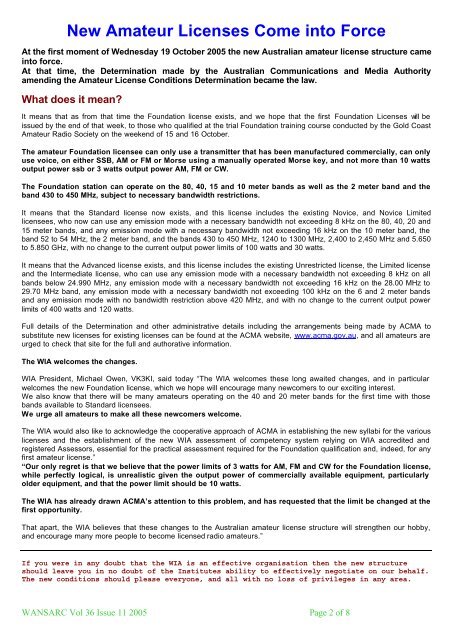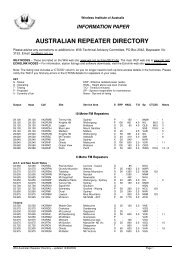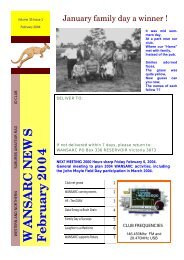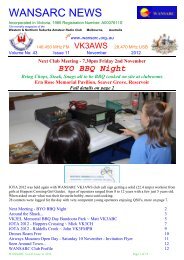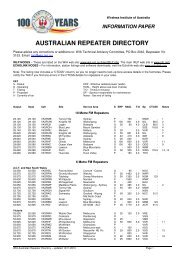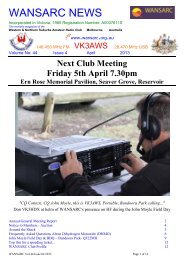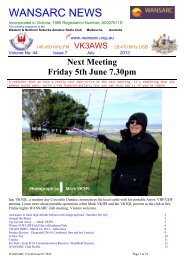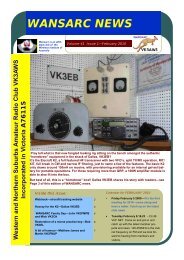WANSARC Vol 36 Issue 11 2005.pdf - Western & Northern Suburbs ...
WANSARC Vol 36 Issue 11 2005.pdf - Western & Northern Suburbs ...
WANSARC Vol 36 Issue 11 2005.pdf - Western & Northern Suburbs ...
You also want an ePaper? Increase the reach of your titles
YUMPU automatically turns print PDFs into web optimized ePapers that Google loves.
New Amateur Licenses Come into Force<br />
At the first moment of Wednesday 19 October 2005 the new Australian amateur license structure came<br />
into force.<br />
At that time, the Determination made by the Australian Communications and Media Authority<br />
amending the Amateur License Conditions Determination became the law.<br />
What does it mean<br />
It means that as from that time the Foundation license exists, and we hope that the first Foundation Licenses will be<br />
issued by the end of that week, to those who qualified at the trial Foundation training course conducted by the Gold Coast<br />
Amateur Radio Society on the weekend of 15 and 16 October.<br />
The amateur Foundation licensee can only use a transmitter that has been manufactured commercially, can only<br />
use voice, on either SSB, AM or FM or Morse using a manually operated Morse key, and not more than 10 watts<br />
output power ssb or 3 watts output power AM, FM or CW.<br />
The Foundation station can operate on the 80, 40, 15 and 10 meter bands as well as the 2 meter band and the<br />
band 430 to 450 MHz, subject to necessary bandwidth restrictions.<br />
It means that the Standard license now exists, and this license includes the existing Novice, and Novice Limited<br />
licensees, who now can use any emission mode with a necessary bandwidth not exceeding 8 kHz on the 80, 40, 20 and<br />
15 meter bands, and any emission mode with a necessary bandwidth not exceeding 16 kHz on the 10 meter band, the<br />
band 52 to 54 MHz, the 2 meter band, and the bands 430 to 450 MHz, 1240 to 1300 MHz, 2,400 to 2,450 MHz and 5.650<br />
to 5.850 GHz, with no change to the current output power limits of 100 watts and 30 watts.<br />
It means that the Advanced license exists, and this license includes the existing Unrestricted license, the Limited license<br />
and the Intermediate license, who can use any emission mode with a necessary bandwidth not exceeding 8 kHz on all<br />
bands below 24.990 MHz, any emission mode with a necessary bandwidth not exceeding 16 kHz on the 28.00 MHz to<br />
29.70 MHz band, any emission mode with a necessary bandwidth not exceeding 100 kHz on the 6 and 2 meter bands<br />
and any emission mode with no bandwidth restriction above 420 MHz, and with no change to the current output power<br />
limits of 400 watts and 120 watts.<br />
Full details of the Determination and other administrative details including the arrangements being made by ACMA to<br />
substitute new licenses for existing licenses can be found at the ACMA website, www.acma.gov.au, and all amateurs are<br />
urged to check that site for the full and authorative information.<br />
The WIA welcomes the changes.<br />
WIA President, Michael Owen, VK3KI, said today “The WIA welcomes these long awaited changes, and in particular<br />
welcomes the new Foundation license, which we hope will encourage many newcomers to our exciting interest.<br />
We also know that there will be many amateurs operating on the 40 and 20 meter bands for the first time with those<br />
bands available to Standard licensees.<br />
We urge all amateurs to make all these newcomers welcome.<br />
The WIA would also like to acknowledge the cooperative approach of ACMA in establishing the new syllabi for the various<br />
licenses and the establishment of the new WIA assessment of competency system relying on WIA accredited and<br />
registered Assessors, essential for the practical assessment required for the Foundation qualification and, indeed, for any<br />
first amateur license.”<br />
“Our only regret is that we believe that the power limits of 3 watts for AM, FM and CW for the Foundation license,<br />
while perfectly logical, is unrealistic given the output power of commercially available equipment, particularly<br />
older equipment, and that the power limit should be 10 watts.<br />
The WIA has already drawn ACMA’s attention to this problem, and has requested that the limit be changed at the<br />
first opportunity.<br />
That apart, the WIA believes that these changes to the Australian amateur license structure will strengthen our hobby,<br />
and encourage many more people to become licensed radio amateurs.”<br />
If you were in any doubt that the WIA is an effective organisation then the new structure<br />
should leave you in no doubt of the Institutes ability to effectively negotiate on our behalf.<br />
The new conditions should please everyone, and all with no loss of privileges in any area.<br />
<strong>WANSARC</strong> <strong>Vol</strong> <strong>36</strong> <strong>Issue</strong> <strong>11</strong> 2005 Page 2 of 8


